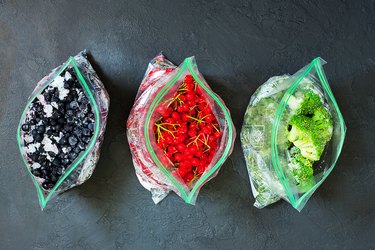
Always having some go-to cooking ingredients on hand makes whipping a meal together — whether it's spaghetti and meat sauce, a quick soup or even a breakfast parfait — that much easier.
But what exactly are the essentials?
Video of the Day
Video of the Day
To start, think about your kitchen as three separate components or areas: There's the pantry or dry storage, the refrigerator and, lastly, the freezer.
Stocking each of these storage areas appropriately will make sure you have what you need on hand to throw together hundreds of easy and nutritious meals.
Pantry

Here are the top 10 food items you'll want to keep in your dry storage or pantry area.
1. Cooking Oil
Cooking oil is a must and olive oil is one of the healthiest and most versatile oils you can stock up on. You can also consider purchasing coconut oil, canola oil or avocado oil. Each has its own benefits, depending on what you're making, but if you had to choose just one, we vote olive oil all the way.
Olive oil is great for coating vegetables before baking or cooking on the stovetop like with this Spicy Tempeh Red Pepper and Sweet Potato Hash or these Balsamic Glazed Brussels Sprouts with Garlic. It adds healthy monounsaturated fats and delicious flavor but it also prevents foods from sticking to pans.
Brands We Love
- O Olive Oil Premium Extra Virgin ($37.63 for a half-gallon on Amazon.com)
- Kirkland Signature Organic Extra Virgin Olive Oil ($30 for 2 liters on Amazon.com)
2. Vinegar
Balsamic and apple cider vinegar are both great to keep on hand. You can use them to help dress a salad like with this Caesar-Style Kale Salad or a simple baby greens salad or cook with vinegar to help balance dishes like this Personal Panzanella.
Brands We Love
- Bragg Organic Raw Unfiltered Apple Cider Vinegar (2-pack for $13.40 on Amazon.com)
- De Nigris Organic Balsamic Vinegar of Modena ($18.95 on Amazon.com)
3. Tomato Paste
Tomato paste is just cooked down tomatoes but it's the trick to upping the flavor on many of your tomato-based recipes.
Give your meat sauce that cooked-all-day-over-the-stove flavor with just a bit of paste or add flavor a depth by adding a tablespoon to a soup like this Homemade Tomato Soup with Mascarpone Cheese and Basil.
Brands We Love
- Amore Sun-Dried Tomato Paste ($6 on Amazon.com)
- San Marzano Double Concentrated Tomato Paste ($8 on Amazon.com)
- Tuscanini Tomato Paste ($11 for a 2-pack on Amazon.com)
Bonus: These tube containers allow you to reuse the paste more easily than the canned varieties, which don't last as long once opened.
4. Canned Tomatoes
Canned food gets a bad rap but sometimes, canning can actually increase specific nutrients in foods, like the amount of iron found in tomatoes. Crushed, diced or whole — they're all versatile. Crushed tomatoes make a great base for a sauce or a stew like with this Osso Bucco.
Brands We Love
- Cento San Marzano Organic ($22.14 for a 6-pack on Amazon.com)
- San Marzano ($46 for a 6-pack on Amazon.com)
5. Canned Beans
Beans are nutrient-dense, a plant-based protein and they're easy on the wallet and Mother Earth.
Plus, canned beans are super convenient. They're great for soups and chilis and are delicious with greens like arugula (like in this Zesty White Bean and Arugula Salad) or added to vegetables and grains to make a nourishing bowl.
Brands We Love
- Eden Organic Kidney Beans($44.57 for 12 cans on Amazon.com)
- Goya Black Beans ($11.19 for a 2-pack on Amazon.com)
6. Canned Tuna Fish
When shopping for canned tuna, look for skipjack or light over albacore — it contains less mercury, according to the Food and Drug Administration.
There's so much you can do with tuna, from this Tangy Tuna Salad in a Collard Wrap to a healthier tuna salad (hint: it uses avocado) or a modern take on a Nicoise salad served in a mason jar.
Brands We Love
- Wild Planet Skipjack Tuna ($31 for a 12-pack on Amazon.com)
- Safe Catch Tuna ($36 for a 12-pack on Amazon.com)
7. Whole Grains
Always keep at least one type of whole grain on hand — although two to three options are even better. Whole grains can go savory or sweet and can stand on their own as a side dish or as an ingredient in a recipe like in this Savory Protein Breakfast Bowl or Farro with Charred Vegetables dish.
Brands We Love
- Bob’s Red Mill Farro ($24.89 for a 2-pack on Amazon.com)
- Nature’s Earthly Choice Quinoa ($10.53 on Amazon.com)
8. Broths
You have your choice — beef, chicken, vegetable, even mushroom — but keeping one or two of these on hand will give you so many options.
Broths are perfect as a base for savory soups like this Acorn Squash Soup with Apple or this spicy Mexican Tomato, Black Bean and Corn Pasta Soup. Broths even work well when sautéing veggies by adding loads of flavor.
Brands We Love
- Imagine Organic Broth ($3 on Amazon.com)
- Savory Choice Reduced Sodium Concentrate ($6 on Amazon.com)
- Emeril’s Stock All-Natural ($32.31 for a 6-pack on Amazon.com)
9. Garlic and Onions
Both garlic and onions are part of the allium family of vegetables. They're also the root (pun intended) of so many wonderful recipes, adding flavor and depth.
They can act as a starring ingredient like in this Sautéed Kale Onion Whole-Wheat Pizza or Chickpea Avocado and Red Onion Salad or can take the role as a crucial flavor builder that lurks in the background like in this Shakshuka Bowl.
10. Salt and Pepper
These might seem obvious but no pantry list is complete without salt and pepper. Always keep your salt and pepper shakers stocked although it's best to leave the salt shaker off the dining table to resist the urge to add oversalt dish.
This Zesty White Bean and Arugula Salad is the perfect example of how these two work together to tie a dish together.
Fridge

Keeping a well-stocked fridge allows you to pair the more perishable items with some of the basics you're storing in your pantry or freezer. Here are six items to always keep on hand.
1. Nuts and Nut Butters
Yes, nuts and nut butters should be stored in the fridge, not the pantry. Nuts are high in fat and the oils can eventually turn rancid. Storing them in colder temps, however, keeps them fresher longer.
The sky's the limit when it comes to using nuts. Start with this Almond Butter and Blueberry Smash Smoothie or this Butternut Squash Salad with Pistachios.
Brands We Love
- Wonderful Pistachios Roasted and Salted ($9.94 on Amazon.com)
- Nuttzo Mixed Nut & Seed Butter ($22 on Amazon.com)
- Food to Live Delux Whole Nuts ($14 on Amazon.com)
2. Tofu
Tofu can last for weeks in your refrigerator and it has a mild flavor, making it one of our favorite kitchen staples. It's also high in protein and plant-based — a total win-win.
Add it to a creamy curry or vegan stir-fry, or even use it as a sub for eggs in the morning when making a breakfast scramble.
Brands We Love
- Nasoya Organic Extra Firm Tofu ($3.39 on Target.com)
- Mori-Nu Tofu ($17.50 for a 3-pack on Amazon.com)
3. Eggs
This is another item that can be a star ingredient or work behind the scene to help pull everything together. A Southwestern Egg Scramble is a must or add just eggs to this Hemp Protein Pancakes recipe.
4. Milk or Non-Dairy Milk
Whether you drink cow's milk or prefer the non-dairy alternatives, keep a carton or bottle stocked in the fridge, always.
You can add it to sweet smoothies, make pink tea lattes (yes, they're a real thing and they're delicious) or even use it when baking protein muffins.
Brands We Love
- Califia Farms Shelf Stable Almond Milk ($28 for a 6-pack on Amazon.com)
- Oatsome Organic Oat Milk ($32.01 per 6-pack on Amazon.com)
- Milkadamia Unsweetened Macadamia Milk ($24.66 for a 6-pack on Amazon.com)
5. Greek Yogurt or Skyr
Greek yogurt and skyr's (Icelandic-style yogurt) tart flavor can go savory or sweet and its creamy texture is the perfect addition to almost any dish.
You can get creative by using it as a base like in this Smoky Harissa Twice-Baked Sweet Potato or keep it simple like in this Raspberry and Greek Yogurt Parfait.
Brands We Love
- Siggi's Fat-Free Plain ($5.99 per container on Amazon.com)
- Fage 2% Greek Yogurt ($5.38 on Amazon.com)
6. Fresh Fruit and Vegetables
Dietitians agree that this one is a must — always keep fresh fruit and veggies and hand.
They can serve as a snack on their own or work as an ingredient in any dish or recipe, like this Roasted Red Grapes and Blue Cheese Salad, Garlicky Zucchini Fries or this Vegan Paleo Rainbow Carrot Poke.
Freezer

Freezer space is prime real estate, so use it wisely by stocking these five items.
1. Frozen Spinach
You can use frozen spinach in warm soups, breakfast smoothies or even healthy snack dips. It adds color, tons of nutrients and volume to most dishes.
A cup of frozen spinach has just 45 calories but provides almost 5 grams of fiber, iron (16 percent Daily Value), vitamin C (10 percent DV), calcium (15 percent DV) and potassium (11 percent DV).
2. Cauliflower Rice
Cauliflower rice is a freezer must, hands down, thanks to its nutrient density and versatility.
You can sub for rice like in this Cauliflower 'Fried Rice' Entrée Bowl or this Orange Chicken and Cauliflower Rice dish. It's also great for adding to smoothies or oatmeal for extra fiber and texture.
3. Frozen Fruit
Bananas, berries, mango, pineapple — almost every fruit holds up well in the freezer. If you're into smoothies, storing your fruit in the freezer instantly adds a creamy and thicker texture to any smoothie or smoothie bowl. They're also great for adding to oatmeal or parfaits.
4. Chicken Breast
The freezer is an ideal spot for boneless, skinless chicken breasts. Make sure to package them individually or in twos, or whatever size make sense for your household because they're nearly impossible to break apart once frozen.
Chicken breasts are a lean source of high-quality protein and they make healthy dishes like this Chicken and Spinach Alfredo or Ginger Chicken Poke.
5. Ground Meat
Beef, turkey, chicken — the choice is yours but ground meat or poultry holds up well in the freezer. In fact, it can last up to four months, according to the USDA.
You can sautée them into a stir-fry, mold them into burgers or try our Buffalo Chicken Mini-Meatball Chili and Instant Pot Turkey Bolognese.